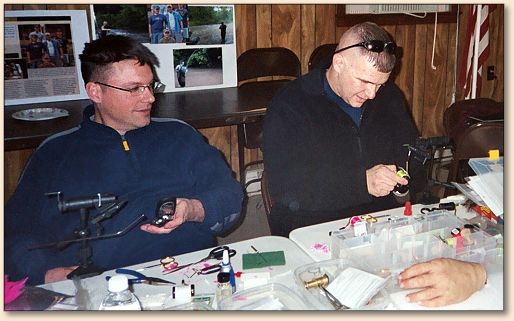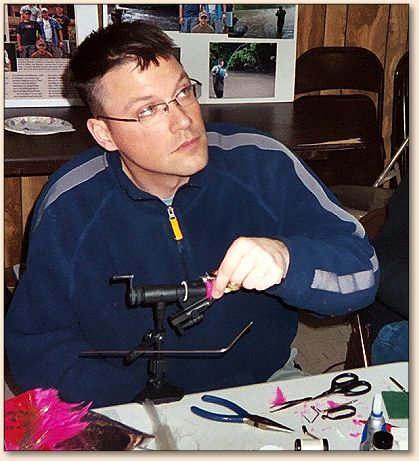|
Fly tying as therapy for military service personnel with
upper arm and hand injuries involving paralysis of the arm
and hand or artificial arms and hands is not a new procedure.
William Black, a noted fly tyer in the World War II era, taught
fly tying to several hundred wounded marines and sailors at the
Great Lakes Naval Hospital during that war. While Mr. Black
started teaching fly tying as recreation for the servicemen,
it was soon shown that the procedures used in tying fishing
flies aided these men to gain more use of the fine motor
skills in their injured arms and hands and with the
relatively crude artificial arms and hands of that era.
When Captain Ed Nicholson (USN, retired) of the National
Capital Chapter of Trout Unlimited (NCC-TU) and a member
of the Federation of Fly Fishers (FFF) and others in NCC-TU
began Project Healing Waters to teach fly casting and fishing
to the war wounded patients at Walter Reed Army Medical Center
(WRAMC), I remembered Bill Blades teaching fly tying in WWII
and decided that I would try to emulate him at WRAMC as a part
of Project Healing Waters.
After examining a number of books, videos, and DVDs on fly
tying, I decided to use Basic Fly Tying, edited
by Jon Rounds and published by Stackpole Books, because of its
clear and well illustrated instructions and because there was
a two disk DVD set based on the book that could be used to give
the patients excellent demonstrations of the use of the fly
tying tools and the procedures used in tying the flies. Marvin
Nolte, an FFF Buz Buszek Award recipient, is a much better fly
tyer than I, and by using the DVDs, the patients could get a
much clearer idea of the procedures than they could by trying
to watch me.
I wrote up a class syllabus based on the book and DVDs and my
prior experience in teaching fly tying classes. Initially the
syllabus called for nine two hour class sessions: an
introduction to the class and familiarization with the tools
and materials; eight sessions teaching the tying of the nine
flies in the book (one session covered tying two versions of
a single fly); and a "graduation" session where the students
would learn to tie a soft hackle fly and then tie one of the
flies learned in the course as a final exam. The time allotted
was actually much more than that allotted for similar classes
I had taught in the past.
In the first session there were five students, four with
prosthetics on their left arms, one with a badly damaged and
partially paralyzed right arm and hand (he was left-handed
before he was wounded), and an occupational therapy technician
who was to work with the students between classes. I had set
a limit of six students for the class. By the fourth week two
of the patients with prosthetics and the OT technician were
transferred from WRAMC, and the class continued with the
three remaining men.
By the second session it was apparent that the instruction
would involve a great deal of individual attention because,
despite similar disabilities, each student had his own
difficulties in performing the skills needed to tie the
flies and many of the tools needed to be modified or
replaced with other types to make it possible for the
students to tie flies. For example, two different bobbins,
five different hackle pliers, and six different vises were
used during the classes, and the students used the tools
they found best suited their particular needs.
At the second class session the students were to tie a
Woolly Bugger, one of the easiest flies that normally
takes less than an hour to learn. Because of their
individual difficulties, the class lasted nearly three
hours. All were able to tie a reasonable Woolly Bugger
and were required to tie a dozen more to be presented
at the next class.
At the third session all the students produced their Woolly
Buggers, including one student whose prosthetic was in the
shop all week, but he tied his dozen with one hand and his
teeth. Any of the Woolly Buggers were fishable and likely
to be taken by fish.
By the end of the fifth session it was apparent that handling
of the elk hair for an Elk Hair Caddis fly would be beyond
the capability of the students with prosthetics, so I changed
to have them tie a Mickey Finn hair wing streamer. It still
involved tying in a hair wing but less difficult than an elk
hair wing.
I decided to depart from the flies in the book and have
the students tie other flies that involved many of the
same procedures but simpler to tie. Besides the Mickey
Finn, the students tied Cone Head Shad Darts, a variety
of foam flies, and several flies of their own design in
addition to the Woolly Bugger, Gold Ribbed Hare's Ear,
and Bead Head Pheasant Tail Nymph that were part of the
lessons in the Basic Fly Tying book.
I also changed the time allotted to each fly from one two
hour session to two sessions of two hours each. At times
some of the students had to miss a class because of hospital
appointments and trips away from WRAMC, and the additional
time gave them a chance to catch up to the others and also
gave me more time to work with the individual problems.

The students have gone to several fishing club meetings
and fly fishing shows to tie flies, not as freaks to be
stared at, but as fellow fly tyers and fishermen. They
talk with the people about Project Healing Waters, fishing
trips they've had and are planning, and how learning to tie
flies has helped in learning to use their prosthetics and
damaged arms and hands for other tasks.
This first class is now finished with formal fly tying
instruction because they have become quite proficient in
many of the techniques involved in fly tying and have
developed some of the fine motor skills that are needed
in daily life. One of the students has been retired from
the service and is attending a local college. The remaining
two students want to help with the new class that will start
in late March.
I want to give my thanks to Colonel Bill Howard, Chief of the
Occupation Therapy Department at WRAMC, for believing in the
therapeutic value of fly tying and allowing me to teach fly
tying to his patients; Ed Nicholson, George Gaines, and the
others from NCC-TU for getting Project Healing Waters under
way and giving me the incentive to teach fly tying to the
"wounded warriors"; to R. P. Van Gytenbeek, CEO and President
of FFF, and the Executive Committee of the FFF's Mid-Atlantic
Council for their encouragement and support of Project Healing
Waters; to Sandy Burk for finding time in her busy life to help
out on a couple of classes; and to the members of FFF clubs and
TU chapters who gave support and donated equipment to Project
Healing Waters and the fly tying program.
I also want to give my heart-felt thanks to some very
special people who, without their efforts, the fly tying
program would never got started:
A very dear friend that I have never met in person, but has
prodded and inspired me with telephone conversations, e-mails,
and her weekly column, "LadyFisher" Deanna Birkholm, publisher
of the best fly fishing web site on the Internet,
FlyAnglersOnLine.com. When she heard about my idea to teach
fly tying to the wounded warriors, she contacted some of the
FAOL supporters and got them to contribute most of the materials
and some of the tools for the course. She also contributed
several dozen Atlantic salmon and steelhead flies that were
entered in the FAOL contest in 2005. These flies will be mounted
in fly plates and sent to FFF to be auctioned at the Conclave and
the proceeds will be reserved for Project Healing Waters.
Anne and Newell Steele, owners of The Angler's Lie in Arlington,
VA, (the best fly shop I've seen east of the Mississippi and
better than most west of it) who contacted many of their suppliers
and got donations of most of the fly tying tools for the classes
and gave substantial discounts on the tools and materials I had
to buy. They also gave me a lot of encouragement and support
when I most needed it.
There are a great many others who gave equipment, money, support
and encouragement who have my thanks, and if I don't thank you
in person, you will get stars in your crowns.

Finally, I want to thank the young men who stuck it out and tied
damned good flies: Eivind Forseth (1st Lieutenant, Infantry, US
Army, shown above), where were you when I could have used a good platoon leader?
Sean Locker (Sergeant, US Marne Corps, shown in photo below), keep tying those wild
Woolly Buggers and your other designs. Jose Ramos (ex-Hospital
Corpsman, US Navy), don't let those college courses keep you
from fly tying-it helps you keep your sanity. You're great guys,
and I enjoyed tyin' and lyin' with you.

I feel that while I haven't taught them to tie more flies,
I have helped them develop the skills they can use to tie
many different flies with help from books, videos, and other
fly tyers. I am confident that they can and will make fly
tying and fly fishing a part of their lives, and I'm glad I
had the opportunity to teach these young men something that
will enrich their lives. ~ John Colburn,
|



